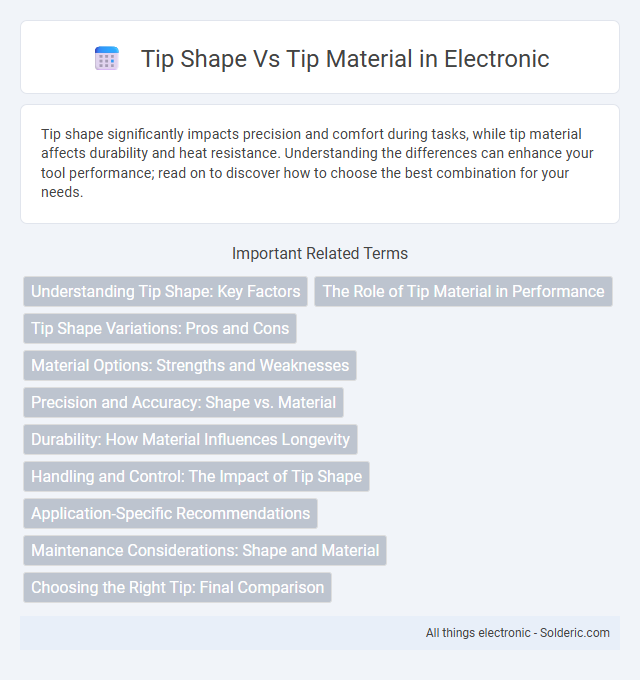Tip shape significantly impacts precision and comfort during tasks, while tip material affects durability and heat resistance. Understanding the differences can enhance your tool performance; read on to discover how to choose the best combination for your needs.
Comparison Table
| Aspect | Tip Shape | Tip Material |
|---|---|---|
| Definition | Form or contour of the tool's tip (e.g., pointed, rounded, chiseled) | Substance composing the tip (e.g., steel, tungsten, ceramic) |
| Function | Determines precision, contact area, and cutting style | Impacts durability, heat resistance, and wear rate |
| Common Types | Conical, Flat, Beveled, Needle, Chisel | Carbon steel, High-speed steel (HSS), Carbide, Ceramic, Diamond-coated |
| Performance Factors | Accuracy, penetration, finish quality | Hardness, toughness, thermal stability |
| Applications | Fine engraving, soldering, marking, cutting | Heavy-duty machining, electronics, jewelry making |
| Wear and Maintenance | Shape affects how quickly the tip dulls or deforms | Material dictates lifespan and sharpening frequency |
Understanding Tip Shape: Key Factors
Tip shape significantly influences performance characteristics such as precision, durability, and application suitability, with common shapes including conical, chisel, and round variants. Each shape offers distinct advantages: conical tips provide fine control for detailed work, chisel tips excel in broader coverage and strong contact, while round tips are preferred for smooth, uniform applications. Understanding the interplay between tip shape and material, like stainless steel or brass, helps optimize tool selection for specific tasks, balancing factors like wear resistance and thermal conductivity.
The Role of Tip Material in Performance
Tip material significantly influences performance by affecting durability, heat conduction, and precision during use. High-quality materials like tungsten carbide or ceramic provide enhanced wear resistance and heat retention, leading to consistent results over time. Your choice of tip material directly impacts the efficiency and accuracy of tasks demanding fine control and longevity.
Tip Shape Variations: Pros and Cons
Tip shape variations, including conical, chisel, and bevel designs, influence precision, control, and durability in applications like soldering or writing instruments. Conical tips offer fine detail and accuracy but may wear out quickly, while chisel tips provide broader coverage and longer lifespan at the expense of fine control. Bevel tips balance precision and surface contact, making them ideal for tasks requiring moderate detail and efficient heat transfer or ink flow.
Material Options: Strengths and Weaknesses
Tip materials like steel, titanium, and ceramic each offer unique strengths and weaknesses affecting durability and performance. Steel tips provide excellent strength and wear resistance but can be heavier, whereas titanium tips are lighter with superior corrosion resistance yet may be less durable under heavy stress. Ceramic tips deliver high hardness and heat resistance but tend to be brittle, making your choice dependent on the specific application requirements and desired tip longevity.
Precision and Accuracy: Shape vs. Material
Tip shape significantly influences precision by determining the contact area and control during application, with finer or tapered shapes enabling more accurate placement. Tip material affects accuracy through its rigidity and wear resistance, as harder materials maintain sharpness longer, reducing deformation and ensuring consistent performance. Combining an optimal tip shape with durable materials like tungsten carbide enhances overall precision and reliability in high-accuracy tasks.
Durability: How Material Influences Longevity
Tip material significantly impacts the durability and longevity of a tool, with harder substances like tungsten carbide offering superior resistance to wear and deformation compared to softer metals such as steel or brass. Materials with high hardness and tensile strength maintain sharpness longer, reducing the frequency of replacement and enhancing overall performance. The combination of tip shape and material hardness optimizes durability, where pointed or chisel shapes made from robust materials withstand heavy use and abrasive conditions more effectively.
Handling and Control: The Impact of Tip Shape
Tip shape significantly influences handling and control by determining the precision and stability of each movement. Pointed tips offer superior accuracy for detailed tasks, while rounded or chisel tips provide broader control and smoother strokes. Choosing the right tip shape enhances your ability to execute fine or bold actions effectively.
Application-Specific Recommendations
Choosing the right tip shape and tip material depends heavily on your specific application, as each combination offers unique performance benefits. For precision soldering tasks, fine conical tips made from copper cores with iron plating provide excellent heat transfer and durability, ideal for small electronic components. When working with larger joints or heavy gauge wires, chisel tips paired with nickel or chromium plating deliver efficient heat distribution and long-lasting wear resistance, ensuring optimal results.
Maintenance Considerations: Shape and Material
Tip shape impacts maintenance frequency, with pointed tips requiring more precise cleaning to avoid damage. Tip material, such as copper or stainless steel, determines durability and heat retention, influencing how often replacement or reconditioning is necessary. Your choice should balance ease of maintenance with the demands of your specific application to maximize tool lifespan.
Choosing the Right Tip: Final Comparison
Selecting the right tip for optimal performance depends on balancing tip shape and tip material, as each directly influences precision, durability, and application suitability. Pointed tips offer fine detail work but require harder materials like tungsten or steel to resist wear, while rounded or chisel tips provide broader strokes better suited to softer materials such as rubber or silicone. Evaluating the specific task requirements and matching them to the tip's geometric design and composition ensures both accuracy and longevity in usage.
tip shape vs tip material Infographic

 solderic.com
solderic.com